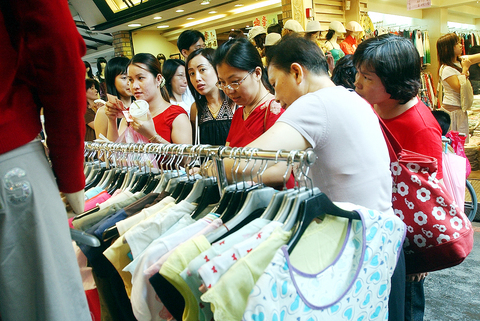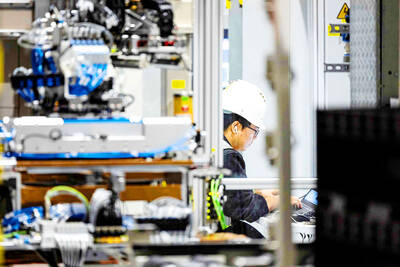Taiwan's Far Eastern Textile Ltd (
Exports of Chinese textiles have rocketed since the abolition of a global quota system at the start of this year, and the US and EU fear that the flood of cheap China-made goods will leave their local industries in tatters.
However, "if [demand for goods from] China turns bad, my output from Southeast Asia and other areas outside China would pick up," said Douglas Hsu (

PHOTO: AP
Like many Taiwanese companies, Far Eastern was quick to use China as a manufacturing base because of its low costs. But it can still tap its other overseas factories to meet demand if production in China drops on the threat of protectionist quotas.
The company, Taiwan's largest maker of chemical fiber and textiles by capacity, derives 70 percent of its revenue from chemical fiber production and the rest from textiles. One-third of Far Eastern Textile's polymer production last year, or about 400,000 tonnes, came from its factories in China, according to the company's data for last year.
Hsu said Far Eastern Textile's production outside China has grown in the wake of US and EU restrictions on different categories of Chinese textiles, but he didn't give specific figures.
The European Commission in June set limits on 10 kinds of textile products from China. Six categories -- shirts, bras, flax yarn, sweaters, men's pants and blouses -- exceeded limits in July and August. Chinese and European officials met this past week in China to seek a compromise on the textile issue.
The US, meanwhile, has imposed emergency quotas on eight Chinese apparel products and is considering 11 more. The US and China have also agreed to hold another round of negotiations on textile shipments before the end of this month.
The textile industry in China could be hit by the new quotas in the second half of this year, but would not affect his business very much, Hsu said.
"We're cross-border," Hsu said. Overall, "the new quota has little impact on us."
Far Eastern Textile, also the world's fifth-largest chemical fiber maker by capacity, posted a modest decline in second-quarter net profit from the same period last year, Hsu said, but declined to give specific figures. The company reported net profit of NT$3.89 billion (US$120.4 million) in the second quarter of last year.
He said the company's chemical fiber business was hit by excess capacity in China.
"In the second quarter, China's excess capacity in the chemical fiber industry remained high, resulting in falling prices in the country," Hsu said.
"At the same time, the cost of raw material was rising," he said. "There was a [margin] squeeze."
Hsu said the huge market for chemical fibers and textiles in China has created many competitors.
"Businesses and trading activities are mostly liberalized now. Everyone's production volume is quite big ... so competition is getting fierce," he said.
He said the company's second-quarter net profit was also pressured by lower earnings from its investments.
The company holds stakes in 67 companies, more than half of which are publicly traded, according to Far Eastern Textile's annual report for last year.
Far Eastern Textile holds a 34 percent stake in mobile phone operator FarEasTone Telecommunications Co (
Far Eastern and FarEasTone are scheduled to report second-quarter results to the Taiwan Stock Exchange at the end of the month.
Far Eastern Textile reported first-quarter net profit of NT$2.75 billion, up 10 percent from the first quarter last year. The quarterly profit was boosted by non-operating income of NT$3.07 billion, according to the Taiwan Stock Exchange.

CHIP RACE: Three years of overbroad export controls drove foreign competitors to pursue their own AI chips, and ‘cost US taxpayers billions of dollars,’ Nvidia said China has figured out the US strategy for allowing it to buy Nvidia Corp’s H200s and is rejecting the artificial intelligence (AI) chip in favor of domestically developed semiconductors, White House AI adviser David Sacks said, citing news reports. US President Donald Trump on Monday said that he would allow shipments of Nvidia’s H200 chips to China, part of an administration effort backed by Sacks to challenge Chinese tech champions such as Huawei Technologies Co (華為) by bringing US competition to their home market. On Friday, Sacks signaled that he was uncertain about whether that approach would work. “They’re rejecting our chips,” Sacks

It is challenging to build infrastructure in much of Europe. Constrained budgets and polarized politics tend to undermine long-term projects, forcing officials to react to emergencies rather than plan for the future. Not in Austria. Today, the country is to officially open its Koralmbahn tunnel, the 5.9 billion euro (US$6.9 billion) centerpiece of a groundbreaking new railway that will eventually run from Poland’s Baltic coast to the Adriatic Sea, transforming travel within Austria and positioning the Alpine nation at the forefront of logistics in Europe. “It is Austria’s biggest socio-economic experiment in over a century,” said Eric Kirschner, an economist at Graz-based Joanneum

BUBBLE? Only a handful of companies are seeing rapid revenue growth and higher valuations, and it is not enough to call the AI trend a transformation, an analyst said Artificial intelligence (AI) is entering a more challenging phase next year as companies move beyond experimentation and begin demanding clear financial returns from a technology that has delivered big gains to only a small group of early adopters, PricewaterhouseCoopers (PwC) Taiwan said yesterday. Most organizations have been able to justify AI investments through cost recovery or modest efficiency gains, but few have achieved meaningful revenue growth or long-term competitive advantage, the consultancy said in its 2026 AI Business Predictions report. This growing performance gap is forcing executives to reconsider how AI is deployed across their organizations, it said. “Many companies

France is developing domestic production of electric vehicle (EV) batteries with an eye on industrial independence, but Asian experts are proving key in launching operations. In the Verkor factory outside the northern city of Dunkirk, which was inaugurated on Thursday, foreign specialists, notably from South Korea and Malaysia, are training the local staff. Verkor is the third battery gigafactory to open in northern France in a region that has become known as “Battery Valley.” At the Automotive Energy Supply Corp (AESC) factory near the city of Douai, where production has been under way for several months, Chinese engineers and technicians supervise French recruits. “They